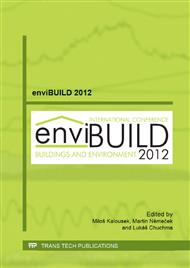p.65
p.69
p.73
p.77
p.81
p.85
p.89
p.93
p.97
Assessing the Risk Relative to Indoor Environment Quality in Education Buildings
Abstract:
The study involves the risk factors analysis for indoor environment quality in education buildings with high occupancy, in terms of the occupants’ vulnerability, but also in terms of the effects of environmental factors on the constructive elements. Integrated risk assessment methodology for environment quality has to establish clear assessment methods, verification and validation of models, identifying factors that influence the environment quality and the possibility of improving their effects. This paper presents the application results of risk assessment methodology concerning the health and intellectual performance of occupants caused by indoor environmental quality for an education building. Are taken into account the results obtained from systematic measurements, over a specified period, of higrothermal parameters and of CO2 content in atmosphere, in a classroom. The analysis conclusions allow some recommending solutions for the risk reduction through constructive measures and improvement of way it is used.
Info:
Periodical:
Pages:
81-84
Citation:
Online since:
January 2013
Authors:
Price:
Сopyright:
© 2013 Trans Tech Publications Ltd. All Rights Reserved
Share:
Citation:


